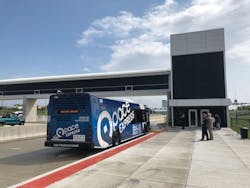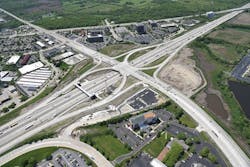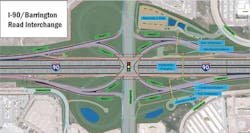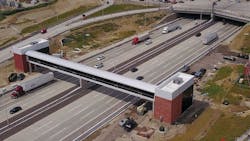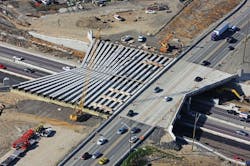The addition of dedicated bus service on I-90 near Chicago strengthens the suburban tie
Multimodal connectivity is becoming an increasingly popular concept in addressing congestion and quality-of-life issues.
While there are abundant models and best practices for integrating alternative forms of transportation into city streets, highways present unique challenges that are just beginning to be explored. A recent interchange project in suburban Chicago is demonstrating how innovative engineering and collaborative processes can be used to introduce mobility options to a regional interstate.
The Barrington Road at Jane Addams Memorial Tollway (I-90) Interchange and Park-n-Ride project is the first in Illinois to integrate an in-line transit station along a mainline interstate corridor—and one of only a few in the nation that does it the way it was done here. It features bus ramps within the interchange, and pedestrian underpasses and an enclosed pedestrian bridge to provide access to the bus station from the commuter parking lot.
“When I was deep in the day-to-day activities, this project seemed to move along as a project typically does. But when I look back now, it is kind of amazing how it progressed from simply improving an interchange for a community to arriving at this multimodal solution that is getting a lot of attention at a national level,” said Charles “Tice” Cole, project manager for Crawford, Murphy & Tilly, the prime engineering consultant on the project.
The village of Hoffman Estates’ Barrington Road Interchange is a groundbreaking project that incorporates a transit component into an Illinois Tollway-connected improvement for the first time in the agency’s history. Achieving this feat required engineering ingenuity, balancing the needs and priorities of several agencies, and committing to a fast-track schedule for completion.
Integrating transit facilities in an interchange infrastructure project did not arise as a grand idea in a moment of inspiration; rather, it progressed out of a culmination of priorities, circumstances, and best practices that were furthered along by a philosophy of always getting the most value from every opportunity.
It started when the village of Hoffman Estates began examining the benefits of transforming the limited-access interchange at Barrington Road and I-90 to full access. Planners for the village knew that a full-access interchange would not only reduce commuter times, it would also spur economic development in the area and reduce emergency response times for crashes on the tollway.
“We had one goal of including some level of transit analysis; however, the partners did not have specific solutions in mind,” said Michael Hankey, director of transportation and engineering for Hoffman Estates. “In fact, at one point the transit component of the Phase I study was reduced significantly as there were no imminent plans for transit at the time.”
A community of 51,000 located around 30 miles from Chicago in the northwest suburbs, the village’s growth is dependent on commuters having easy access to the metropolitan area. While the Chicago metropolitan area has significant rail transit options, this suburban community was established and grew thanks to tollway access. Therefore, any transit solution would have to supplement the existing transportation infrastructure.
The new, full-access SPUI interchange replaces the previous limited-access interchange, while occupying a smaller footprint than the original, partial clover leaf interchange. In-line transit access, a pedestrian bridge and tunnel, and 170 free parking spaces for commuters were also accommodated. The preliminary concept facilitated the selection of a preferred interchange type, while also allowing Pace to pursue its transit goals.
GETTING UNDERWAY
Barrington Road is a north-south strategic regional arterial serving several suburban communities. It is also an unmarked state route under the jurisdiction of the Illinois DOT (IDOT). In 2005, IDOT implemented a policy that requires a Context Sensitive Solution (CSS) process be held on major highway improvement projects. The workshops bring together all the project’s stakeholders to not only look for ways to save money, but also to consider value-added solutions.
“Since these (workshops) have been implemented, we have worked diligently to thoughtfully engage stakeholders in the planning and design of major highway improvement projects,” said John Baczek, IDOT program development engineer. “These policies have also helped ensure we improve mobility by providing an inclusive multimodal transportation solution within the scope and budget of our projects. Issues such as traffic congestion from home to work, suburban sprawl, preservation of scenic landscapes and historic neighborhoods, and the ability to use our transportation system to walk, bike, and access public transit are much higher priorities to stakeholders than they ever have been.”
As a major user of the I-90 corridor and a key agency in the area transportation community, the Regional Transportation Authority (RTA) was among the stakeholders brought to the table to brainstorm during the CSS process. One of RTA’s divisions is Pace Suburban Bus, a public transit agency that was looking for opportunities to add more park-n-ride facilities along the expressway as part of its market expansion program.
“It all really started with Pace’s Bus-on-Shoulder program on I-55, which proved that if you can provide fast and reliable bus service, many people will choose it over driving their own vehicles,” said Pace’s Executive Director Rocky Donahue.
Adding a transit component was also of great interest to another stakeholder, the Illinois Tollway, the agency that operates the Jane Addams Memorial Tollway (I-90) that carries nearly 350,000 vehicles daily.
As it enters Illinois from the west at Beloit, Wisconsin, I-90 runs east for approximately 80 miles to the Chicago city limits. The Barrington Road Interchange location along the tollway proved fortuitous to its managing agency for a couple of reasons. The Illinois Tollway was moving forward with a $2.5 billion expansion of the I-90 expressway and had been coordinating with the village of Hoffman Estates and local stakeholders as the Barrington Road interchange was in its planning phase. During coordinating efforts, Tollway staff identified that a new bridge at the interchange would be needed to accommodate the widened road. To fully take advantage of this opportunity, the design team for the interchange committed to completing the planning and design on an accelerated schedule, so that construction could be completed during the Tollway’s reconstruction and widening phases.
In conjunction with the interchange project, the Tollway saw the reconstruction of its 50-year-old roadway as the opportunity to continue to explore new ways to address congestion. With the $2.5 billion expansion, completed in 2016, the new I-90 Tollway also now includes a full lane-width inside shoulder with reinforced pavement designed as a flex lane to support bus rapid transit and active traffic management. The ability to incorporate transit along the corridor was critical to the Tollway’s mission of delivering infrastructure improvements that also envision support for future solutions to traffic demand and needs.
“Committing Tollway resources to planning for integration and support of transit on the Illinois Tollway is intended to make it easier and more efficient for our customers to use I-90, either by car or bus, to better reach the communities, jobs, and businesses. The unique configuration of the new interchange and transit station reduces the amount of time buses are off the roadway, while also improving safety, enhancing mobility, and reducing congestion on the roadway,” said Illinois Tollway Executive Director José Alvarez.
The architectural style of the overpass and associated buildings was modeled after existing plazas throughout the Tollway system. Significant modifications were made to the building design to address the unique needs of transit users.
INTEGRATION
IDOT wanted to maintain progressive traffic flow along Barrington Road by sufficiently spacing traffic signals. The single point urban interchange (SPUI) type that was eventually chosen is the first of its kind on the Illinois Tollway system. With a much smaller footprint than the cloverleaf configuration it would replace, the SPUI interchange not only provided reduced environmental impact, it also freed up Tollway owned land immediately adjacent to the Tollway to accommodate the Park-n-Ride facility.
“Following the comprehensive stakeholder involvement program based on CSS, a vision for what has essentially become a multimodal transit center in the middle of the interchange was created,” Baczek said.
The preferred transit alternative in service today has buses exit I-90 using the exit ramp then diverge, accessing a bus-only ramp that runs parallel to the expressway to reach the stations, which are located on the north and south sides, east of the interchange bridge. After boarding, the bus merges onto the entrance ramp and rejoins the I-90 mainline traffic.
“As we were developing alternatives, we researched a handful of projects throughout the country where transit was being integrated, using bus pullouts and other things,” Cole said. “The big advantage of the design we came up with is that the buses don’t have to traverse side streets or encounter traffic signals. With the in-line stations, it’s a quick stop, and then they’re on their way again.”
Pace desired an operation of five minutes or less at the station. The design provided a four-minute operation. Compared to the historical alternative of accessing the station from the local side streets, the in-line station saves an additional four to six minutes of travel time.
This single point urban interchange (SPUI), the first of its kind in Illinois, uses flared, precast, prestressed bulb T-beams. Benefits of this solution include reduced costs and faster erection time, while minimizing the size of the bridge deck. The design also allowed four lanes of traffic to be maintained throughout construction.
“A pedestrian bridge over the tollway and two tunnels passing beneath ramps allow commuters to access eastbound and westbound buses with ease. All of these features have reframed the conversation about interchange design and multimodal planning in a way that benefits all users and encourages economic development,” Donahue said.
While the village of Hoffman Estates is enjoying the benefits that it first sought by pursuing a full-access interchange at Barrington Road, the project’s evolution into a multimodal solution is opening new avenues for transportation agencies looking to relieve congestion without adding additional vehicular lanes to its roadway systems.
“This experience serves to encourage our ongoing work to develop a regional network of rapid transit services,” Donahue said. “We now have clear examples of rapid transit and express service success to show our stakeholders, including the people who travel using Pace, businesses, schools, and governmental bodies. Our pitch will be easier, and we can offer tangible proof that when you implement good public transportation service, people choose it.”
Transit agencies throughout the country will certainly be interested in a solution that successfully integrates their services into an expressway system. Others in the transportation and engineering communities are also taking notice, with the project earning several industry awards at both the state and national levels. As multimodal concepts continue to progress, the Barrington Road project is providing a pivotal step forward.
“The planning, design, and complete reconstruction of the I-90 at Barrington Road interchange has taken multimodal planning with integrated roadway and transit strategies to new heights,” Baczek said.
